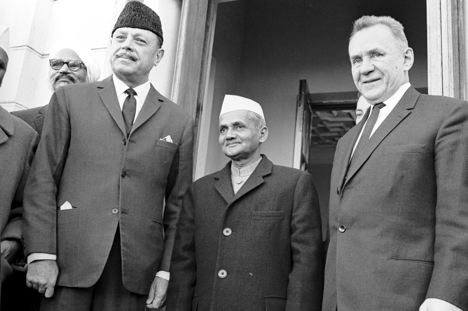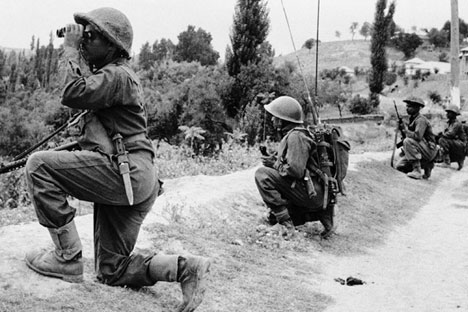At Tashkent, Soviet peace over India and Pakistan

From left: President of the Islamic Republic of Pakistan Muhammad Ayub Khan, Prime Minister of independent India Lal Bahadur Shastri, and the USSR Council of Ministers Chairman, the CPSU Central Committee Politburo member Alexei Kosygin before the Taskent meeting between the heads of government of India and Pakistan, mediated by the USSR.
Valeriy Shustov/RIA NovostiThe 50th anniversary of the Tashkent Declaration, an agreement ending hostilities between India and Pakistan, was marked on Sunday, January 10. The declaration was signed in the Soviet Union, after mediation by Soviet diplomacy, personally led by Alexei Kosygin, head of the Council of Ministers. This document is considered one of the finest examples of diplomatic mediation by the Soviet Union in world politics, even though the resulting peace did not last long.
The agreement between India and Pakistan, ending the largest military conflict over territorial disputes since World War II, was signed on January 10, 1966 in Tashkent, capital of what was then the Uzbek SSR. When negotiations were initiated, the conflict between India and Pakistan was seriously threatening stability in the region. This conflict between two major regional powers was threatening to escalate into a much larger scale war, with participation of other states. India was being threatened by China, which was then was an ally of Pakistan. Beijing was accusing Delhi of aggression.
This alarmed the Soviet Union as well as the United States, which feared a Chinese intervention in the conflict. The American authorities had no particular influence on the Chinese leadership, while the relations between the Soviet Union and China were hostile then. The Great Powers decided to use their influence in the UN Security Council to impose a cease-fire, and once the relevant resolution was adopted by the Security Council in September 1965, both countries agreed to comply with it.
However, the cease-fire was fragile and the conflict could have resumed at any time. Feeling the need for a more binding agreement, the Soviet Union proposed to act as a mediator, with the personal participation of Kosygin, Chairman of the USSR Council of Ministers. According to memoirs of contemporaries, Kosygin played a crucial role in reaching a settlement in the Indo-Pakistani conflict, as he enjoyed the confidence of both sides.
An important part was also played by the fact that the Pakistani President Mohammad Ayub Khan, while leading his country in step with US policy, was also interested in improving relations with the Soviet Union. However, the main factor that played a positive role at the beginning of the negotiation process was the fact that both the Soviets and Americans were equally interested in resolving the conflict.
Mohammad Ayub Khan and Indian Prime Minister Lal Bahadur Shastri travelled to Tashkent for the negotiations. Both leaders were very powerful and sophisticated politicians. The negotiations were not easy; both sides exchanged accusations, placing the responsibility for starting the conflict on the other.
However, diplomatic efforts were successful and India and Pakistan signed the Tashkent Declaration, which obliged both countries to cease hostilities, withdraw all military forces to the positions they held prior to the start of the conflict, and resume diplomatic ties.
A picture in the Soviet magazine Ogonyok, the Indian and Pakistani leaders are seen holding hands, and standing next to them is a smiling Kosygin. “Peace and cooperation – that is what the historic Tashkent Declaration means, and the whole world has heard of it,” wrote the magazine. Next to this text was another, with a photo of Indian Prime Minister Shastri in a black frame.
The night after the Declaration was signed, the Indian leader died of a heart attack. He became ill right after the talks, and attempts by leading cardiologists could not save Shastri’s life.
Circumstances surrounding the Indian Prime Minister’s death are still shrouded in mystery; the KGB even suspected that the cooks had poisoned him, but later these suspicions were removed. In the West, they preferred to lay blame on the USSR for the death of Shastri.
Despite this tragic event, the Tashkent Declaration was considered a great success of Soviet diplomacy in the resolution of international conflicts. The Declaration did not go down well in India. The agreement was endorsed by the Indian National Congress Party and the Communist Party of India, but opposition parties said the peace treaty had demoralized the country.
The Tashkent Declaration “did not lead to the resolution of the crisis”, says Peter Topychkanov. Peace between the two countries lasted six years. In 1971, a new military conflict broke out between India and Pakistan, resulting in the splitting of its eastern part from Pakistan, on which the state of Bangladesh was declared. A new ceasefire was signed between the parties in December 1971. Relations between India and Pakistan remain tense, and the state of Jammu and Kashmir continues to be a place of constantly occurring cross-border conflicts.
According to some analysts, it is hard to draw lessons for the resolution of current conflicts from the Tashkent Declaration, but Topychkanov believes that Soviet diplomacy managed to do then what could not be done later.
“The Soviet Union was active and, by attempting to create favorable conditions, could act as a mediator in the crisis. This was a success that had little chances of being repeated.”
The article is abridged. Read the full version in Russian at Gazeta.ru.
All rights reserved by Rossiyskaya Gazeta.
Subscribe
to our newsletter!
Get the week's best stories straight to your inbox
